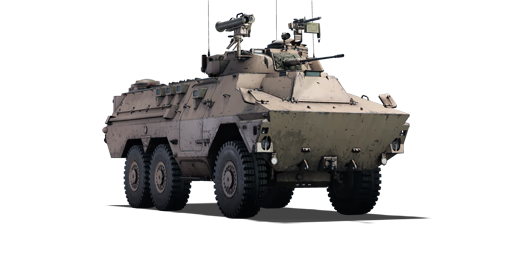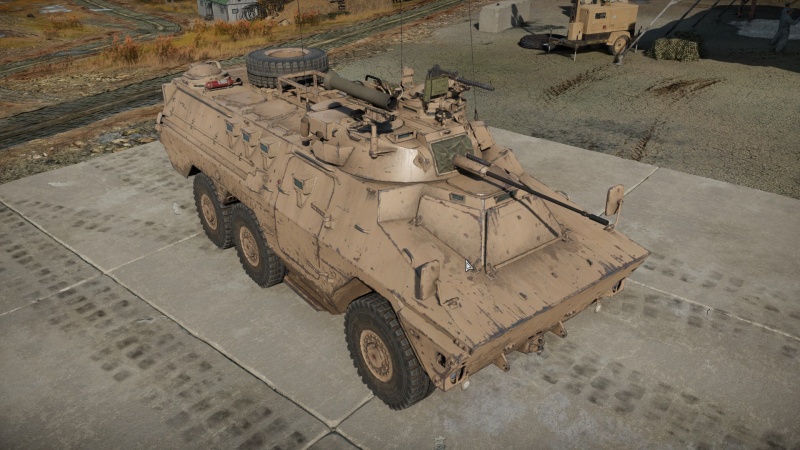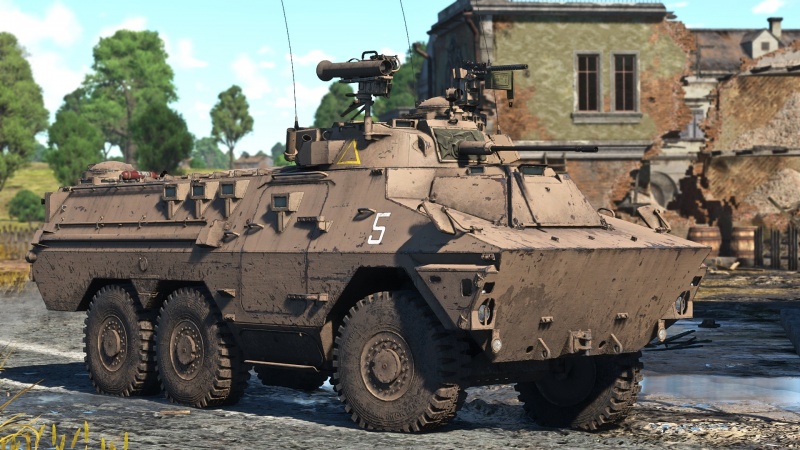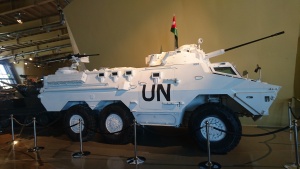Ratel 20
| This page is about the British light tank Ratel 20. For other versions, see Ratel (Family). |
Contents
Description
The Ratel family of IFVs came to be in 1976 in South Africa to meet the needs of the South African Army. It pioneered many different areas of IFV development, such as being the first IFV in the world of a wheeled design to enter service worldwide, and the introduction of mine-protecting hulls on IFVs. The choice of a wheeled hull was due to the region's expansive deserts and relative lack of harsh terrain, as well as the longevity provided by wheels over tracked vehicles of similar types in maintenance. The Ratel 20 was the base variant of the Ratel family of IFVs, equipped with a 20 mm autocannon and MILAN anti-tank guided missiles. During its service with various militaries and international organizations, some of which still use the Ratels in active service, the Ratels provided valuable mobility and firepower to the lowest levels of the army, but were also often forced into situations beyond what they were originally designed for.
The Ratel 20 was introduced in Update "Ixwa Strike". Keeping in line with the previous Ratel 90, it is in terms of chassis virtually unchanged. The only noticeable difference from the Ratel 90 is the turret and as a result the tank's armament, switching out the low velocity 90 mm gun for the original base configuration of a 20 mm autocannon and 7 MILAN ATGMs. This brings with it some playstyle changes, such as being able to use terrain more aggressively due to the increased gun depression and possibility of launching anti-tank missiles without presenting an easy target at short range, while losing the ability to directly go through enemies as the autocannon is not strong enough to fight medium tanks head-on. As the hull is underpowered for both the Ratel 20 and 90, it is recommended that you pick ground that has relatively mild terrain features (but not none) to utilize your tank's above average gun angles but also level enough that your tank doesn't struggle moving up and down a hill.
General info
Survivability and armour
The Ratel 20 is not very different from the Ratel 90 at a first glance - the crew positioning and armour are identical and are quite poor. The turret and hull sides are vulnerable to 12.7 mm MG and the hull roof will implode if exploded by any kind of high explosives, but the armour is also thin enough to not trigger APHE at many angles of attack. The crew is quite tightly packed and there is only 3 members, so a bad hit to the middle of the tank will easily destroy the tank in RB and is likely to make it useless in AB.
What is different is the ammunition placement - there are no longer random HEAT shells scattered across the tank, instead there are small boxes of 20 mm shells behind the driver's head and a stack of ATGMs next to the engine on the left side. This greatly reduces the chances of being obliterated in a single shot, although a knowing opponent might just shoot the ATGM storage from the side.
The ATGM on top of the vehicle is a blessing and a curse at the same time - its positioning allows to repel incoming tanks without exposing the tank itself, but it can also detonate if hit hard enough and then overpressure the carrier, so at least some caution is advised when fighting a competent enemy.
Two smoke groups can be fired to create a 90 degree smoke screen in turret direction. The grenades fire rather far, so it will take longer than average to deploy, but it may also allow to use smoke offensively.
Armour type:
- Rolled homogeneous armour (hull, turret, cupola)
- Cast homogeneous armour (gun mantlet)
- Wheel (tires, suspension rods)
- Bulletproof glass (driver windows)
| Armour | Front (Slope angle) | Sides | Rear | Roof |
|---|---|---|---|---|
| Hull | 15 mm (30°) Front plate 10 mm (75°) Upper Glacis 20 mm (30°) Lower plate |
8 mm (26°) Top 10 mm (2-27°) Bottom |
10 mm (0-43°) | 6 mm |
| Turret | 12 mm (30°) Turret front 12 mm (8°) Gun mantlet |
10 mm (17-21°) | 10 mm (16°) | 10 mm (16°) Front part 10 mm Rear part 8 mm Gunner hatch |
| Cupola | 8-10 mm (spherical) | 8 mm (46-85°) Hatch | ||
Notes:
- Wheels and suspension are 10 mm thick.
- Belly is 8 mm thick.
- Unlike Ratel 90, the radiator's armour is 10 mm instead of 5 mm thick.
Mobility
The mobility is identical to the Ratel 90. While it is slightly lighter, expecting this tank to drive any faster or to handle better than a giant armoured bus is unreasonable. As before, wheeled configuration allows it to accelerate faster on paved roads or off a hill and to carry its momentum when going off-road, which is necessary to get to the points of interest faster than other tanks.
In RB: when off road it will go -18 km/h in reverse, or begrudgingly drive 30 km/h forward with very slow acceleration past that mark. On a road it can drive around 72 km/h mark if given enough time to accelerate.
In AB: when off road it will go -20 km/h in reverse, or drive around 60 km/h forward with slow acceleration past that mark. Driving off a hill might push it to 72 km/h easily. When driving on a road, it might reach 96 km/h, but it might start sliding at this point and easily lose control if turned too hard.
| Game Mode | Max Speed (km/h) | Weight (tons) | Engine power (horsepower) | Power-to-weight ratio (hp/ton) | |||
|---|---|---|---|---|---|---|---|
| Forward | Reverse | Stock | Upgraded | Stock | Upgraded | ||
| Arcade | Expression error: Unexpected * operator. | 437 | Expression error: Unexpected round operator. | __.__ | |||
| Realistic | 249 | Expression error: Unexpected round operator. | __.__ | ||||
Modifications and economy
Armaments
Main armament
The 90 mm cannon was replaced by a 20 mm autocannon. The turret is not very different, so someone used to Ratel 90 will not find it too difficult to adapt to its behaviour. The cannon can aim higher than usual, allowing it to aim at the sky when needed, but it may require a hill to aim above the tank itself.
Autocannon fire rate is reasonably high, and the ammunition belts consist of 150 shells, so suppressing fire is an option, but the cannon can overheat if it fires 70 shots without pause, so if the target cannot be suppressed or destroyed with this ammunition amount, it is better to attack with ATGM immediately or to think of a better plan.
Almost all medium tanks (as well as heavy tanks) will be able to ignore the 20 mm autocannon, so in a direct engagement with heavier vehicles the autocannon can only be used to damage their externals (such as the tracks or cannons) and maybe engines or commander cupolas (as they sometimes have less armour than the rest of the tank).
| 20 mm GI-2 | Turret rotation speed (°/s) | Reloading rate (seconds) | ||||||||||||
|---|---|---|---|---|---|---|---|---|---|---|---|---|---|---|
| Mode | Capacity (Belt) | Fire rate | Vertical | Horizontal | Stabilizer | Stock | Upgraded | Full | Expert | Aced | Stock | Full | Expert | Aced |
| Arcade | 1,200 (150) | 750 | -8°/+38° | ±180° | N/A | 22.7 | 31.4 | 38.1 | 42.1 | 44.8 | 10.40 | 9.20 | 8.48 | 8.00 |
| Realistic | 14.2 | 16.7 | 20.2 | 22.4 | 23.8 | |||||||||
Ammunition
All of the 20 mm belts consist of HVAP and HEI in different proportions.
HEI is a rather straightforward anti-air shell - it deals heavy damage upon hitting the aircraft or open-topped SPG and is useless against fully enclosed tanks.
HVAP has a rather high flat penetration for the calibre, but has abysmal angled penetration, to a point of being unable to penetrate the hull of some heavily angled light SPG and tanks. It also lacks the stopping power of the APDS and cannot overpenetrate engines, so while it can set them on fire, it will not hit anything past the engine decks (unless there are holes that could be punched through).
- Default: HVAP-T · HEI-T*
- HE, 20 mm: HEI-T* · HEI-T* · HVAP-T
- AP, 20 mm: HVAP-T · HVAP-T · HEI-T*
| Penetration statistics | |||||||
|---|---|---|---|---|---|---|---|
| Ammunition | Penetration @ 0° Angle of Attack (mm) | ||||||
| 10 m | 100 m | 500 m | 1,000 m | 1,500 m | 2,000 m | ||
| HVAP-T | 57 | 52 | 37 | 24 | 15 | 10 | |
| HEI-T* | 6 | 6 | 4 | 3 | 2 | 2 | |
| Shell details | ||||||||||||
|---|---|---|---|---|---|---|---|---|---|---|---|---|
| Ammunition | Velocity (m/s) |
Projectile mass (kg) |
Fuse delay (m) |
Fuse sensitivity (mm) |
Explosive mass (TNT equivalent) (g) |
Ricochet | ||||||
| 0% | 50% | 100% | ||||||||||
| HVAP-T | 1,100 | 0.11 | - | - | - | 66° | 70° | 72° | ||||
| HEI-T* | 1,054 | 0.12 | 0.1 | 0.1 | 27.2 | - | - | - | ||||
Ammo racks
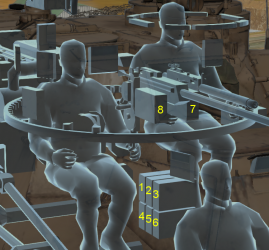
| Full ammo |
Ammo type |
1st rack empty |
2nd rack empty |
3rd rack empty |
4th rack empty |
5th rack empty |
6th rack empty |
7th rack empty |
8th rack empty |
Visual discrepancy |
|---|---|---|---|---|---|---|---|---|---|---|
| 10 1,200 |
Clips Rounds |
9 (+1) 1,080 |
8 (+2) 960 |
7 (+3) 840 |
6 (+4) 620 |
4 (+6) 480 |
3 (+7) 360 |
2 (+8) 240 |
1 (+9) 120 |
Yes |
Notes:
- Ammunition is modelled as 10 clips of 120 rounds.
- The visual discrepancy concerns the number of clips: 10 clips can be fired but only 8 are modeled.
Additional armament
As an additional weapon, the tank carries an Anti-Tank Guided Missile (ATGM) launcher on its top-right side. The ATGM in question is MILAN, which is one of the easier missiles to control and navigate, as it is rather agile and forgiving. The missile is controlled via sniper crosshairs as it is semi-automatic, which means that it doesn't block the driver controls when fired, unlike other early missiles, but requires the target to be visible the entire time.
The control point can be swapped between the 20 mm autocannon and the launcher itself with a special hotkey, but the missile Line-Of-Sight (LOS) is calculated off the 20 mm regardless. To hit the target past 160 m, tank autocannon must see the target, or at least the missile itself, otherwise the missile will automatically fall down. The only way to counteract this is to fire the missile into the sky and redirect it into the enemy at the very last second, but even this might be pushing the limits of the tank.
If directly controlled, the ATGM launcher can turn about 30 degrees away from the main gun horizontally, aim 5 degrees down or 15 degrees up. This mostly mirrors the usual angles of attack of the main gun.
In terms of the damage, consider MILAN as a very big HEAT shell with very high penetration - angle of attack most of the times means nothing, as the missile flight path can be corrected at any time, but low explosive mass (in TNT equivalent) means that the hit must be directed into some kind of a fatal weak spot, be it a big ammo rack or the crew compartment. The missile also has rather low overpressure damage, but a direct hit on light tank weakspots with less than 15 mm of armour may prove fatal anyway.
| MILAN missile | |||
|---|---|---|---|
| Capacity | Vertical | Horizontal | Stabilizer |
| 7 | ±5° | N/A | N/A |
Ammunition
| Penetration statistics | |||||||
|---|---|---|---|---|---|---|---|
| Ammunition | Type of warhead |
Penetration @ 0° Angle of Attack (mm) | |||||
| 10 m | 100 m | 500 m | 1,000 m | 1,500 m | 2,000 m | ||
| MILAN | ATGM | 530 | 530 | 530 | 530 | 530 | 530 |
| Missile details | ||||||||||||
|---|---|---|---|---|---|---|---|---|---|---|---|---|
| Ammunition | Type of warhead |
Velocity (m/s) |
Range (m) |
Projectile mass (kg) |
Fuse delay (m) |
Fuse sensitivity (mm) |
Explosive mass (TNT equivalent) (kg) |
Ricochet | ||||
| 0% | 50% | 100% | ||||||||||
| MILAN | ATGM | 200 | 2,000 | 6.7 | 0.05 | 0.1 | 1.83 | 80° | 82° | 90° | ||
Ammo racks
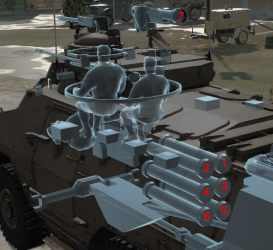
| Full ammo |
Visual discrepancy |
|---|---|
| 7 | No |
Notes:
- Missiles are modeled individually and disappear after having been launched.
- It is not possible to select how many missiles to bring into battle.
- The missiles deplete from 1 to 7.
Machine guns
| 7.62 mm Browning MG4 | ||||
|---|---|---|---|---|
| Mount | Capacity (Belt) | Fire rate | Vertical | Horizontal |
| Coaxial | 3,000 (250) | 500 | - | - |
| Pintle | 3,000 (250) | 500 | -10°/+3° | ±120° |
Usage in battles
Use your excellent mobility on roads to flank the enemy and use your autocannon to hit side and rear armour. If you ever come face to face with a heavily armoured vehicle, use your ATGM. On rough terrain, support your teammates and use your ATGMs to pick off targets passing by. You can also help repair teammates and destroy lightly-armoured targets with your autocannon. Since your 20 mm isn't very useful against most tanks from the front, use it to take out tracks and gun barrels. The ratel is very long and hard to hide so always be careful that you are not exposing sections of your vehicle that the enemy can see. If opponent is charging your position and is closer than 200 m away, you can pull the launcher out and use it directly to stop them even if the autocannon is unable to control the missile.
Pros and cons
Pros:
- MILAN ATGM has good penetration values and is very easy to control, very hard to miss
- Although the missile launcher cannot truly control the missiles, it still can fire at anyone closer than 160 m directly without exposing the tank itself, which can be powerful both in offence and defence
- Ratel chassis is decently mobile when roads are present once fully upgraded; also has great reverse speed of 17 km/h
- 20 mm GI-2 gun has a high rate of fire and a useful elevation of +38°; perfect against low flying aircraft
Cons:
- Large size; difficult to conceal and manoeuvre on urban maps
- ATGM cannot be fired on the move, so unlike the Ratel 90 this tank often cannot "just rush" positions
- No stabilizer; the vehicle must stop to use the GI-2 cannon against medium/heavy tanks or over longer ranges
- Low engine power; the wheels also struggle on snow, sand or mud
- HVAP loaded into GI-2 cannon has poor performance against even light sloped armour plates as those on BMP-1 (Family), 2S1, C13 T90, etc
- Armour is unreliable and poor; only 3 crew members and a large ATGM rack
History
Development
Named after the tenacious honey badger[1], the Ratel Infantry Fighting Vehicle's development began in 1970 when the South African Defence Force required armoured vehicles which could cover the vast distances of the African plains. These requirements prioritised strong firepower and good protection to enable mechanised infantry to play their role within a highly mobile warfare doctrine. The SADF were already using British APCs, but these aligned with the British doctrine of mobilised infantry dismounting for engagements which was counter-intuitive to the direction of the diverging South African structure[2]. The SADF also used South African-designed armoured vehicles, yet these were liable to breakdowns and weapon failures which peaked during the South African Border War, exposing the weaknesses of older and cheaper IFV models and exposing the necessity for complete replacement to the more durable and reliable Ratel models. The South African derivative of the AML, the Eland was successful as a reconnaissance vehicle with remarkable self-defence, and this would inspire the design of the Ratel which shares visual similarity[2].
Combat usage
The Ratel would enter production in 1975 and see immediate success in the Angolan War from 1978. Despite a design based around flat terrain and infantry combat, the Ratel found itself excelling in challenging mountainous terrain and rainforests, fulfilling additional combat and support roles. In later produced modular variants, the Ratel utilised the cannon turret of the Eland, ATGMs, and also support platforms such as observation and logistics[3].
The Ratel-20 would see combat in Operation Reindeer, 1978, Operation Sceptic, 1980, Operation Askari, 1983, and Operation Excite, 1988 for the SADF in Angola[2]. It still serves several African nations in the present day, including South Africa which maintains over one thousand Ratel IFVs in total comprising a significant percentage of the SADF's land fighting capability, and Ratel-20s have been used extensively by countries participating in United Nations peacekeeping missions[4].
Media
- Skins
- Videos
See also
- Other vehicles based on the Ratel chassis:
Vehicles of similar design and role:
External links
- Bibliography
- ↑ Scheepers, M., Pretorius, F. (2021) 'Loss of military equipment by the SADF at the Battle at Indungo during the Border War, 31 October 1987', Scientia Militaria, South African Journal of Military Studies, Vol 49, Nr 2, pp. 58-9.
- ↑ 2.0 2.1 2.2 Harmse, K., Dunstan, S. (2017) South African Armour of the Border War 1975–89. Oxford: Osprey Publishing, pp. 18-47.
- ↑ O'Malley, T.J. (1996) Fighting Vehicles: Armoured Personnel Carriers and Infantry Fighting Vehicles. London: Merlin Publications, pp. 98-9.
- ↑ Wezeman, P. (2011). 'South African Arms Supplies to Sub-Saharan Africa', Stockholm International Peace Research Institute.
| Sandock-Austral | |
|---|---|
| Ratel | Ratel 90 · Ratel 20 · ZT3A2 |
| Eland | Eland 90 Mk.7 |
| Britain light tanks | |
|---|---|
| A13 | A13 Mk I · A13 Mk I (3rd R.T.R.) · A13 Mk II · A13 Mk II 1939 |
| A15 | Crusader II · Crusader "The Saint" · Crusader III |
| A17 | Tetrarch I |
| IFV | Warrior · Desert Warrior (Kuwait) |
| Wheeled | Daimler Mk II · AEC Mk II · Fox · Vickers Mk.11 |
| Other | VFM5 |
| South Africa | |
| SARC | SARC MkIVa · SARC MkVI (2pdr) · SARC MkVI (6pdr) |
| Ratel | Ratel 90 · Ratel 20 |
| Rooikat | Rooikat Mk.1D · Rooikat 105 · Rooikat MTTD |
| Other | Concept 3 · Eland 90 Mk.7 |
| USA | Stuart I · Stuart III |


